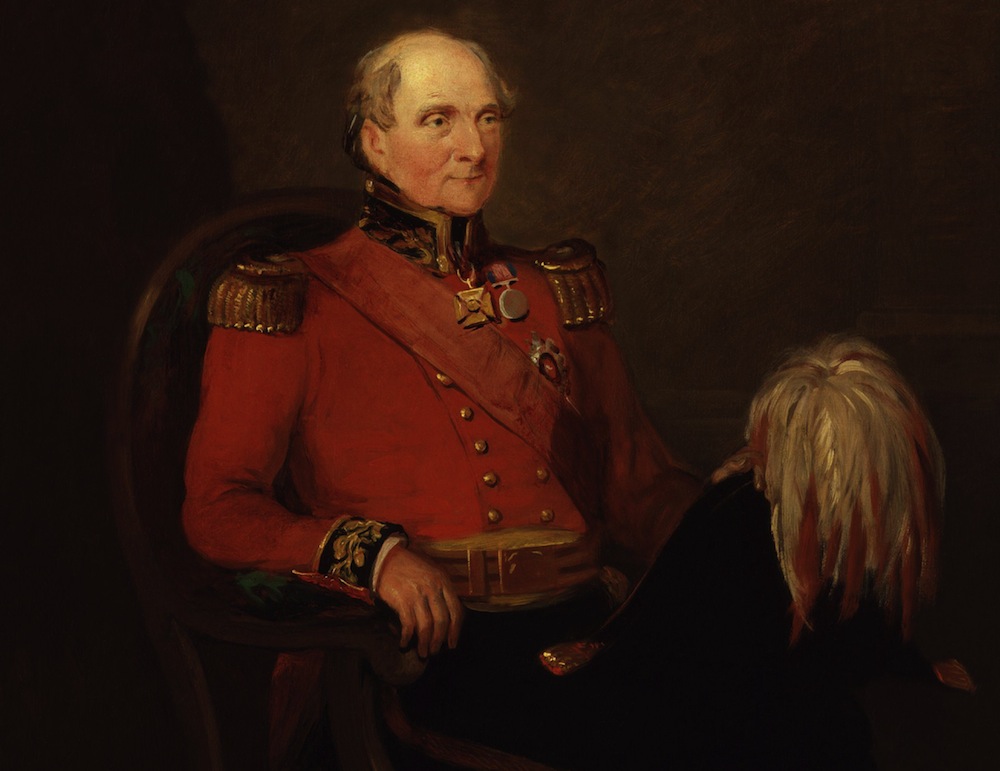
Guest writer Stephen Roberts finds out a little more about a Shrewsbury man who made a military mark.
There are three Rowland Hills of note. One, the originator of the penny-post, came from Kidderminster. The second was a popular preacher, born in Shropshire in the 1740s, but the one of interest to us came a generation later, born in August 1772 at Prees Hall, Hawkstone Park, near Market Drayton.The Book of British Birthplaces correctly states that 1st Viscount Hill was a military commander who distinguished himself in the Napoleonic Wars… but erroneously places Grade II Listed Prees Hall in Cheshire. In fact, this derelict country house of the early 18th century is in Church Street, Prees; definitely a part of Shropshire. Hill was born here, the fourth of 16 children of John Hill, third Baronet Hawkstone.
Why the interest? Well, this Hill is the one commemorated atop the Grade II listed column that stands impressively outside Shrewsbury’s Shirehall. Built between 1814 and 1816, when the subject had just been awarded the freedom of the City of London, the column is 133 feet 6 inches high, with a 17 foot statue of Hill gracing it. The architect was another Shropshire man, Edward Haycock of Shrewsbury.
 A timely reminder
A timely reminder
In this year that marks the 200th anniversary of the Battle of Waterloo, let’s celebrate a man of Shropshire who was there. A general who distinguished himself in Egypt, then under Wellington in Spain’s Peninsular War, Hill did his bit that day in Belgium, sweeping France’s ‘old guard’ from the field as Napoleon met his Waterloo.
At the time, Hill was 42, Commander of II Corps, and Wellington’s trusted second-in-command. Wellington reputedly said of his deputy that he always knew where to find him; a good quality on a battlefield.
Compared to the frosty Iron Duke, Hill was genuinely loved by his men, who referred to him as ‘Daddy Hill’ due to the kindness and generosity he showed them. Another nickname was ‘Farmer’, owing to his ruddy countenance. One wag suggested at the time of his ennoblement in 1814 that he should have been dubbed ‘Lord Mountain’ because he was a ‘great Hill’.
At Waterloo, Hill was nominally in command of II Corps, but the Allied command structure has been described as ‘eccentric’ and ‘pliable’ and, on the ground, Hill was effectively leading the right-wing, which came up against Napoleon’s vaunted Imperial Guard in close-quarter fighting. Hill’s horse was killed under him, and he himself came away confused and with severe bruising.
A gentle start
Despite loving pets and gardening as a boy, Hill opted for a military life, rather than the law, the career choice followed by four of his brothers.
Hill was commissioned in 1790, when he would have been just 18 or so, and attended military school in Strasbourg. In 1801, commanding the 90th Foot against the French at Aboukir Bay in Egypt, Hill was seriously wounded when a musket-ball hit his head. One can only imagine he was tough-headed, as he shrugged off this small matter, proceeding to help drive the French out of Egypt in the weeks following.
Battle scarred
In fact, he was back in the line of duty just one month later. Hill would endure further trials, wounded at the Battle of Talavera in 1809 and catching malaria the year afterwards. He would be wounded again at Almaraz in 1812, but bounced back, for at the Nive in 1813, Wellington boasted that Hill had given the French ‘the soundest thrashing they ever had’.
Hill went on to become Shrewsbury’s MP in 1812, having retired to Hardwicke Grange near Shrewsbury, where he became an enthusiastic foxhunter. In 1821 Hill bore the royal standard at George IV’s coronation and in 1828, he succeeded Wellington as Army commander-in-chief when the Duke became Prime Minister, continuing in this post until 1842.
Enduring failing health, Hill, who never married, resigned shortly before his death, aged 70. He was laid to rest in the churchyard at Hadnall, four miles north-east of Shrewsbury – but, thanks to the towering presence which greets visitors who enter the town, his memory will be preserved forever.
Join the Friends of Lord Hill’s Column!
A dedicated group have taken it upon themselves to maintain the column and the statue that sits at its uppermost point. The Friends invite people to pay a lifetime fee of £5, which allows you to climb the column as many times as you wish, with prior arrangement. Climbers ascend 172 steps inside the column – the largest of its type in England – and the viewing platform gives unsurpassed views of Shropshire. The statue itself is rather unusual, as it’s made of ‘coade stone’, an artificial stone developed by Exeter-born Eleanor Coade in the 18th century – but it now needs replacing, as it’s showing the effects of 200 years of exposure to the elements.
To find out more, visit friendsoflordhillscolumn.co.uk or email l.r.hayes@btinternet.com.






